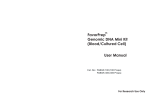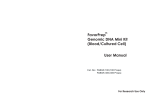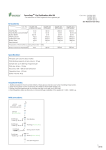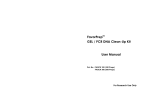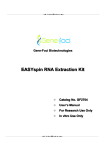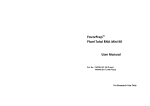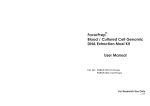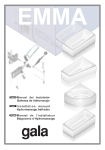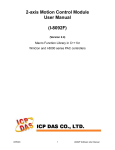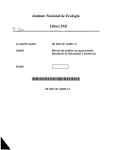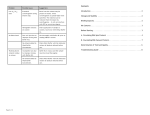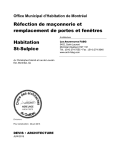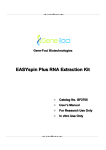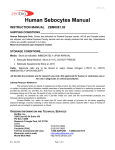Download FavorPrep Blood / Cultured Cell Genomic DNA
Transcript
FavorPrep Blood / Cultured Cell Genomic DNA Extraction Mini Kit TM User Manual Cat. No.: FABGK 001 (50 Preps) FABGK 001-1 (100 Preps) FABGK 001-2 (300 Preps) For Research Use Only v.1002 Introduction TM FavorPrep Genomic DNA Extraction Mini Kit is an excellent tool offering a speedy and economic method to purify total DNA (e.g. genomic, mitochondrial and viral DNA) from whole blood (fresh or frozen), plasma, serum, buffy coat, body fluids, lymphocytes and cultured cells. This technology first lyses cells and degrades protein by using a chaotropic salt and Proteinase K, then binds DNA to silica-based membranes, washes DNA with ethanol-contained Wash Buffer and then elutes purified DNA by low salt Elution Buffer or ddH2O. Compare with other harmful and time-consuming procedures, such as phenol/chloroform TM extraction and ethanol precipitation, FavorPrep shortens the handling time within 1 hour. The size of purified DNA is up to 50 Kb (predominantly 20 - 30 Kb). After using FavorPrep TM Genomic DNA Extraction Mini Kit, the high quality total DNA can be used directly for the downstream applications. Specification Sampling: up to 200 µl of whole blood (with anti-coagulant), plasma, 6 serum, buffy coat, or body fluids; up to 5 x 10 lymphocytes or cultured cells in 200 µl PBS. Yield: about 5 µg of total DNA from 200 µl of human whole blood; up to 50 µg of total DNA, depends on the sample types and the number of cells in the sample. Handling time: within 1 hour, depends on the sample types. 1 -FABGK FABGK-1 4 Kit Contents Storage Conditions FavorPrep TM FABGK001 (50preps) Genomic DNA Extraction Mini Kit except Proteinase K can be stored at room temperature 15 - 25oC for up to 1 year. Proteinase K powder can be stored dry at room temperature for up to 6 months. For storage longer than 6 months Proteinase K o powder should be stored dry at 2-8 C. Proteinase K stock FABGK001-1 (100preps) FABGK001-2 (300preps) FABG Buffer 15 ml 30 ml 70 ml W1 Buffer* 22 ml 44 ml 124 ml Wash Buffer** 10 ml 20 ml 50 ml Elution Buffer 15 ml 30 ml 30 ml x 3 11 mg x 2 11 mg x 6 solution is stable for 2 months when stored at 2-8 C. Storage at -20 C Proteinase K*** 11 mg will prolong its life, but repeated freezing and thawing should be avoided. FABG Mini Column 50 pcs 100 pcs 300 pcs 100 pcs 200 pcs 600 pcs 50 pcs 100 pcs 300 pcs o o Collection Tube Elution Tube *Add 8 / 16 / 45 ml ethanol (96~100%) to W1 Buffer when first open. **Add 40 /80 / 200 ml ethanol (96~100%) to Wash Buffer when first open. ***Add 1.1 ml sterile ddH2O to each Proteinase K tube to make a 10mg/ml stock solution. 1 3 -FABGK FABGK-2 Important Notes Trouble Shooting 1. Buffers provided in this system contain irritants. Wear gloves and lab coat when handling these buffers. 2. Add 1.1 ml sterile ddH2O to each Proteinase K tube to make a 10mg/ml stock solution. Vortex and make sure that Proteinase K has been Problem Possible Reasons/ Solution A280/A280 ratio of 5. The volume or the percentage of eluted DNA is ethanol is not correct before adding low into Wash Buffer ‧Make sure that the correct volumes of ethanol (96 - 100%) is added into completely dissolved. Store the stock solution at 4 C. o Wash Buffer when first open. Repeat the extraction procedure with a new sample. 3. For FABGK 001(50preps), add 8ml ethanol (96~100%) to W1 Buffer when first open. For FABGK 001-1 (100presp), add 16 ml ethanol (96~100%) to W1 6. Genomic DNA is contaminated ‧Do not wet the rim of the column Buffer when first open. For FABGK 001-2 (300presp), add 45 ml ethanol during sample and buffer loading. (96~100%) to W1 Buffer when first open. A280/A280 ratio of 4. For FABGK001 (50preps), add 40ml ethanol (96~100%) to Wash Buffer when first open. For FABGK 001-1 (100preps), add 80 ml ethanol (96~100%) to Wash eluted DNA is high 1. A lot of residual RNA in eluted DNA ‧Follow the General Protocol step 2 to remove RNA. 2. FABG Buffer added to the sample before Buffer when first open. For FABGK 001-2 (300preps), add 200 ml ethanol adding RNase A (96~100%) to Wash Buffer when first open. ‧Make sure that Rnase A has been added to the sample before adding FABG Buffer when using optional RNase step. 5. Preheat a dry bath or a water bath to 60oC before the operation. 6. All centrifuge steps are done at full speed (14,000 rpm or 10,000 xg) in a microcentrifuge. Degradation of eluted DNA 1. Sample is old ‧Always use fresh or well-stored sample for genomic DNA extraction. 2. Buffer for gel electrophoresis contaminated with DNase ‧Use fresh running buffer for gel electrophoresis. 3 -FABGK FABGK-1 2 Trouble Shooting Problem Brief Procedure Possible Reasons/ Solution A280/A280 ratio of Poor cells lysis eluted DNA is 1. Poor cell lysis because of insufficient low Proteinase K activity ‧Repeat the extraction procedure with a new sample. Use a fresh or well-stored Proteinase K stock solution. ‧Do not add Proteinase K directly to FABG Buffer. 2. Poor cell lysis because of insufficient mixing with FABG Buffer ‧Repeat the extraction procedure with a new sample. Mix the sample and FABG Buffer immediately and throughly by pulse-vortexing. 3. Poor cell lysis because of insufficient incubation time ‧Repeat the extraction procedure with a new sample. Extend the incubation time and make ( W1 Buffer ) ( Wash Buffer ) sure that no residual particulates remain. Ethanol is not added into the lysate before transferring sample mixture into FABG Mini Column ‧Repeat the extraction procedure with a new sample. Incorrect preparation of Wash Buffer 4. Ethanol is not added into Wash Buffer when first open ‧Make sure that the correct volumes of ethanol (96 - 100%) is added into Wash Buffer when first open. Repeat the extraction procedure with a new sample. 1 1 -FABGK FABGK-4 General Protocol Please Read Important Notes Before Starting The Following Steps. HINTP: Preheat a 60 C dry bath or water bath for step 4. o Trouble Shooting Problem Possible Reasons/ Solution 2. Ethanol is not added into the lysate before transferring sample mixture into FABG Column 1.Transfer up to 200 µl sample (whole blood, buffy coat) to ‧Repeat the extraction procedure with a a micropcentrifuge tube (not provided). new sample. ‧If the sample volume is less than 200 µl, add the appropriate volume of PBS. 2. (Optional): If RNA-free genomic DNA is required, add 4 µl of 100 mg/ml RNase A to the sample and incubate for 2 minutes at room temperature. Brown residues remain on the column membrane after washing Buffer when first open. Repeat the ‧Make sure that the correct volumnes of ethanol (96~100%) is added into Wash Buffer when first open. Repeat the incubation, vortex the sample every 3 - 5 minutes. extraction procedure with a new sample. 5. Briefly spin the tube to remove drops from the inside of the lid. 6. Add 200 µl ethanol (96~100%) to the sample. Mix thoroughly 1. Blood sample contains clots by pulse-vortexing for 30 seconds. FABG Column to a new Collection tube. ethanol (96~100%) is added into Wash into Wash Buffer 4. Incubate at 60oC for 15 minutes to lyse the sample. During Centrifuge for 1 minute and discard the flow-through then place ‧Make sure that the correct volumnes of ethanol is not correct before adding ‧Do not add Proteinase K directly to FABG Buffer. mixture (including any precipitate) carefully to FABG Column. when first open B. The volumn or the percentage of Mix thoroughly by pulse-vortexing. 8. Place a FABG Column to a collection tube. Transfer the sample A. Ethanol is not added into Wash Buffer extraction procedure with a new sample. 3. Add 20 µl Proteinase K and 200 µl FABG Buffer to the sample. 7. Briefly spin the tube to remove drops from the inside of the lid. 3. Incorrect preparation of Wash Buffer ‧Repeat the extraction procedure with a new sample. Mix the blood sample Column is clogged well with anticoagulant to prevent formation of blood clots. 2. Sample is too viscous ‧Reduce the sample volume. 3. Insufficient activity of Proteinase K ‧Use a fresh or well-stored Proteinase K Stock solution.. ‧Repeat the extraction procedure with a new sample. Do not add Proteinase K Into FABG Buffer directly. 5 -FABGK FABGK-1 0 Trouble Shooting Problem Possible Reasons/ Solution B. The volume or the percentage of ethanol is not correct before adding into Wash ‧Make sure that ethanol has been added into W1 Buffer when first open. ‧Make sure that the correct volumes of 10. Wash FABG Column with 750 µl Wash Buffer by centrifuge Buffer when first open. Repeat the extraction procedure with a new sample. of genomic DNA 11. Centrifuge for an additional 3 min to dry the column. A. PH of water (ddH2O) for elution is acidic ‧Important Step! This step will avoid the residual liquid to ‧Use Elution Buffer (provided) for elution . B. Elution Buffer or ddH2O is not completely absorbed by column membrane ‧After Elution Buffer or ddH2O is added, stand the FABG Column for 5 minutes before centrifugation. 1. Poor Cell Lysis A. It is because of insufficient Proteinase K activity ‧Repeat the extraction procedure with a new sample. Use a fresh or well-stored Proteinase K stock solution. ‧Do not add Proteinase K stock directly to remain on the column membrane after washing for 1 minute then discard the flow-through. ‧Make sure that ethanol has been added into Wash Buffer when first open. 5. Elution of genomic DNA is not efficient ‧Make sure the pH of ddH2O is between 7.5~9.0 . Brown residues centrifugefor 1 minute then discard the flow-through. Buffer ethanol (96~100%) is added into Wash Low or no yield 9. Immediately, Wash FABG Column with 500 µl W1 Buffer by FABG Buffer. B. It is because of insufficient mixing with FABG Buffer ‧Repeat the extraction procedure with a new inhibit subsequent enzymatic reactions. 12. Place FABG Column to Elution Tube. 13. Add 100~200 µl of Elution Buffer or ddH2O (pH 7.5~9.0) to the membrane center of FABG Column. Stand FAGB Column for 3 min. ‧Important Step! For effective elution, make sure that the elution solution is dispensed onto the membrane center and is absorbed completely. ‧Standard volume for elution is 200 µl, If sample has low number of cells, reduce the elution volume (50µl - 150µl ) to increase DNA concert ration. 14. Centrifuge for 2 min to elute the DNA . 15. Store the DNA fragment at 4 C or -20 C. o o sample. Mix the sample and FABG Buffer immediately and thoroughly by pulse-vortexing. C. Poor cell lysis because of insufficient incubation time ‧Repeat the extraction procedure with a new sample. Extend the incubation time and make sure that no residual particulates remain. 9 -FABGK FABGK-6 Trouble Shooting Special Protocol For cultured Cells Problem 1. Harvest Cells a. Cells grown in suspension Possible Reasons/ Solution 1. Low amount of cells in the sample ‧Concentrate a larger volume of a new i. Transfer the appropriate number of cell (up to 5 x 10 ) to a 1.5ml 6 sample to 200 µl. If the sample is whole microcentrifuge tube (not provided). blood, prepare buffy coat (refer to Special Protocol on page 7). ii. Centrifuge at 300 x g for 5 minutes. 2. Poor cell lysis iii. Remove the supernatant carefully and completely. A. it is because of insufficient b. Cells grown in monolayer Proteinase K activity i. Detach cells from the dish or flask by trypsinization or using a cell scraper. ii. Transfer the appropriate number of cell (up to 5 x 10 ) to a 1.5ml 6 microcentrifuge tube (not provided). iii. Centrifuge at 300 x g for 5 minutes. iv. Remove the supernatant carefully and completely. 2. Resuspend cell pellet in PBS to a final volume of 200µl. 3. Follow the General Protocol starting from step 2. Low or no yield of genomic DNA ‧Repeat the extraction procedure with a new sample. Use a fresh or well-stored proteinase K stock solution. B. it is because of insufficient mixing with FABG Buffer ‧Repeat the extraction procedure with a new sample. Mix the sample and FABG Buffer immediately and thoroughly by pulse-vortexing. C. It is because of insufficient incubation time. ‧Repeat the extraction procedure with a new sample. Extend the incubation time Preparation of buffy coat Centrifuge whole blood at 3,300xg for 10 minutes at room temperature and you will get three different fractions: the upper clear layer is plasma; the intermediate layer is buffy coat, containing concentrated leukocytes; the bottom layer contains concentrated erythrocytes. Process the General Protocol from Step 1 for buffy coat. Extraction total DNA from buffy coat will yield 5-10 times more DNA than an equivalent volume of whole blood. and make sure that no residual particulates remain. 3. Ethanol is not added into the lysate before transferring sample mixture into FABG Column ‧Repeat the extraction procedure with a new sample. 4. Incorrect preparation of Wash Buffer A. Ethanol is not added into Wash Buffer when first open. ‧Make sure that the correct volumes of ethanol (96~100%) is added into Wash Buffer when first open. Repeat the extraction procedure with a new sample. 7 -FABGK FABGK-8 Trouble Shooting Special Protocol For cultured Cells Problem 1. Harvest Cells a. Cells grown in suspension Possible Reasons/ Solution 1. Low amount of cells in the sample ‧Concentrate a larger volume of a new i. Transfer the appropriate number of cell (up to 5 x 10 ) to a 1.5ml 6 sample to 200 µl. If the sample is whole microcentrifuge tube (not provided). blood, prepare buffy coat (refer to Special Protocol on page 7). ii. Centrifuge at 300 x g for 5 minutes. 2. Poor cell lysis iii. Remove the supernatant carefully and completely. A. it is because of insufficient b. Cells grown in monolayer Proteinase K activity i. Detach cells from the dish or flask by trypsinization or using a cell scraper. ii. Transfer the appropriate number of cell (up to 5 x 10 ) to a 1.5ml 6 microcentrifuge tube (not provided). iii. Centrifuge at 300 x g for 5 minutes. iv. Remove the supernatant carefully and completely. 2. Resuspend cell pellet in PBS to a final volume of 200µl. 3. Follow the General Protocol starting from step 2. Low or no yield of genomic DNA ‧Repeat the extraction procedure with a new sample. Use a fresh or well-stored proteinase K stock solution. B. it is because of insufficient mixing with FABG Buffer ‧Repeat the extraction procedure with a new sample. Mix the sample and FABG Buffer immediately and thoroughly by pulse-vortexing. C. It is because of insufficient incubation time. ‧Repeat the extraction procedure with a new sample. Extend the incubation time Preparation of buffy coat Centrifuge whole blood at 3,300xg for 10 minutes at room temperature and you will get three different fractions: the upper clear layer is plasma; the intermediate layer is buffy coat, containing concentrated leukocytes; the bottom layer contains concentrated erythrocytes. Process the General Protocol from Step 1 for buffy coat. Extraction total DNA from buffy coat will yield 5-10 times more DNA than an equivalent volume of whole blood. and make sure that no residual particulates remain. 3. Ethanol is not added into the lysate before transferring sample mixture into FABG Column ‧Repeat the extraction procedure with a new sample. 4. Incorrect preparation of Wash Buffer A. Ethanol is not added into Wash Buffer when first open. ‧Make sure that the correct volumes of ethanol (96~100%) is added into Wash Buffer when first open. Repeat the extraction procedure with a new sample. 7 -FABGK FABGK-8 Trouble Shooting Problem Possible Reasons/ Solution B. The volume or the percentage of ethanol is not correct before adding into Wash ‧Make sure that ethanol has been added into W1 Buffer when first open. ‧Make sure that the correct volumes of 10. Wash FABG Column with 750 µl Wash Buffer by centrifuge Buffer when first open. Repeat the extraction procedure with a new sample. of genomic DNA 11. Centrifuge for an additional 3 min to dry the column. A. PH of water (ddH2O) for elution is acidic ‧Important Step! This step will avoid the residual liquid to ‧Use Elution Buffer (provided) for elution . B. Elution Buffer or ddH2O is not completely absorbed by column membrane ‧After Elution Buffer or ddH2O is added, stand the FABG Column for 5 minutes before centrifugation. 1. Poor Cell Lysis A. It is because of insufficient Proteinase K activity ‧Repeat the extraction procedure with a new sample. Use a fresh or well-stored Proteinase K stock solution. ‧Do not add Proteinase K stock directly to remain on the column membrane after washing for 1 minute then discard the flow-through. ‧Make sure that ethanol has been added into Wash Buffer when first open. 5. Elution of genomic DNA is not efficient ‧Make sure the pH of ddH2O is between 7.5~9.0 . Brown residues centrifugefor 1 minute then discard the flow-through. Buffer ethanol (96~100%) is added into Wash Low or no yield 9. Immediately, Wash FABG Column with 500 µl W1 Buffer by FABG Buffer. B. It is because of insufficient mixing with FABG Buffer ‧Repeat the extraction procedure with a new inhibit subsequent enzymatic reactions. 12. Place FABG Column to Elution Tube. 13. Add 100~200 µl of Elution Buffer or ddH2O (pH 7.5~9.0) to the membrane center of FABG Column. Stand FAGB Column for 3 min. ‧Important Step! For effective elution, make sure that the elution solution is dispensed onto the membrane center and is absorbed completely. ‧Standard volume for elution is 200 µl, If sample has low number of cells, reduce the elution volume (50µl - 150µl ) to increase DNA concert ration. 14. Centrifuge for 2 min to elute the DNA . 15. Store the DNA fragment at 4 C or -20 C. o o sample. Mix the sample and FABG Buffer immediately and thoroughly by pulse-vortexing. C. Poor cell lysis because of insufficient incubation time ‧Repeat the extraction procedure with a new sample. Extend the incubation time and make sure that no residual particulates remain. 9 -FABGK FABGK-6 General Protocol Please Read Important Notes Before Starting The Following Steps. HINTP: Preheat a 60 C dry bath or water bath for step 4. o Trouble Shooting Problem Possible Reasons/ Solution 2. Ethanol is not added into the lysate before transferring sample mixture into FABG Column 1.Transfer up to 200 µl sample (whole blood, buffy coat) to ‧Repeat the extraction procedure with a a micropcentrifuge tube (not provided). new sample. ‧If the sample volume is less than 200 µl, add the appropriate volume of PBS. 2. (Optional): If RNA-free genomic DNA is required, add 4 µl of 100 mg/ml RNase A to the sample and incubate for 2 minutes at room temperature. Brown residues remain on the column membrane after washing Buffer when first open. Repeat the ‧Make sure that the correct volumnes of ethanol (96~100%) is added into Wash Buffer when first open. Repeat the incubation, vortex the sample every 3 - 5 minutes. extraction procedure with a new sample. 5. Briefly spin the tube to remove drops from the inside of the lid. 6. Add 200 µl ethanol (96~100%) to the sample. Mix thoroughly 1. Blood sample contains clots by pulse-vortexing for 30 seconds. FABG Column to a new Collection tube. ethanol (96~100%) is added into Wash into Wash Buffer 4. Incubate at 60oC for 15 minutes to lyse the sample. During Centrifuge for 1 minute and discard the flow-through then place ‧Make sure that the correct volumnes of ethanol is not correct before adding ‧Do not add Proteinase K directly to FABG Buffer. mixture (including any precipitate) carefully to FABG Column. when first open B. The volumn or the percentage of Mix thoroughly by pulse-vortexing. 8. Place a FABG Column to a collection tube. Transfer the sample A. Ethanol is not added into Wash Buffer extraction procedure with a new sample. 3. Add 20 µl Proteinase K and 200 µl FABG Buffer to the sample. 7. Briefly spin the tube to remove drops from the inside of the lid. 3. Incorrect preparation of Wash Buffer ‧Repeat the extraction procedure with a new sample. Mix the blood sample Column is clogged well with anticoagulant to prevent formation of blood clots. 2. Sample is too viscous ‧Reduce the sample volume. 3. Insufficient activity of Proteinase K ‧Use a fresh or well-stored Proteinase K Stock solution.. ‧Repeat the extraction procedure with a new sample. Do not add Proteinase K Into FABG Buffer directly. 5 -FABGK FABGK-1 0 Trouble Shooting Problem Brief Procedure Possible Reasons/ Solution A280/A280 ratio of Poor cells lysis eluted DNA is 1. Poor cell lysis because of insufficient low Proteinase K activity ‧Repeat the extraction procedure with a new sample. Use a fresh or well-stored Proteinase K stock solution. ‧Do not add Proteinase K directly to FABG Buffer. 2. Poor cell lysis because of insufficient mixing with FABG Buffer ‧Repeat the extraction procedure with a new sample. Mix the sample and FABG Buffer immediately and throughly by pulse-vortexing. 3. Poor cell lysis because of insufficient incubation time ‧Repeat the extraction procedure with a new sample. Extend the incubation time and make ( W1 Buffer ) ( Wash Buffer ) sure that no residual particulates remain. Ethanol is not added into the lysate before transferring sample mixture into FABG Mini Column ‧Repeat the extraction procedure with a new sample. Incorrect preparation of Wash Buffer 4. Ethanol is not added into Wash Buffer when first open ‧Make sure that the correct volumes of ethanol (96 - 100%) is added into Wash Buffer when first open. Repeat the extraction procedure with a new sample. 1 1 -FABGK FABGK-4 Important Notes Trouble Shooting 1. Buffers provided in this system contain irritants. Wear gloves and lab coat when handling these buffers. 2. Add 1.1 ml sterile ddH2O to each Proteinase K tube to make a 10mg/ml stock solution. Vortex and make sure that Proteinase K has been Problem Possible Reasons/ Solution A280/A280 ratio of 5. The volume or the percentage of eluted DNA is ethanol is not correct before adding low into Wash Buffer ‧Make sure that the correct volumes of ethanol (96 - 100%) is added into completely dissolved. Store the stock solution at 4 C. o Wash Buffer when first open. Repeat the extraction procedure with a new sample. 3. For FABGK 001(50preps), add 8ml ethanol (96~100%) to W1 Buffer when first open. For FABGK 001-1 (100presp), add 16 ml ethanol (96~100%) to W1 6. Genomic DNA is contaminated ‧Do not wet the rim of the column Buffer when first open. For FABGK 001-2 (300presp), add 45 ml ethanol during sample and buffer loading. (96~100%) to W1 Buffer when first open. A280/A280 ratio of 4. For FABGK001 (50preps), add 40ml ethanol (96~100%) to Wash Buffer when first open. For FABGK 001-1 (100preps), add 80 ml ethanol (96~100%) to Wash eluted DNA is high 1. A lot of residual RNA in eluted DNA ‧Follow the General Protocol step 2 to remove RNA. 2. FABG Buffer added to the sample before Buffer when first open. For FABGK 001-2 (300preps), add 200 ml ethanol adding RNase A (96~100%) to Wash Buffer when first open. ‧Make sure that Rnase A has been added to the sample before adding FABG Buffer when using optional RNase step. 5. Preheat a dry bath or a water bath to 60oC before the operation. 6. All centrifuge steps are done at full speed (14,000 rpm or 10,000 xg) in a microcentrifuge. Degradation of eluted DNA 1. Sample is old ‧Always use fresh or well-stored sample for genomic DNA extraction. 2. Buffer for gel electrophoresis contaminated with DNase ‧Use fresh running buffer for gel electrophoresis. 3 -FABGK FABGK-1 2 Kit Contents Storage Conditions FavorPrep TM FABGK001 (50preps) Genomic DNA Extraction Mini Kit except Proteinase K can be stored at room temperature 15 - 25oC for up to 1 year. Proteinase K powder can be stored dry at room temperature for up to 6 months. For storage longer than 6 months Proteinase K o powder should be stored dry at 2-8 C. Proteinase K stock FABGK001-1 (100preps) FABGK001-2 (300preps) FABG Buffer 15 ml 30 ml 70 ml W1 Buffer* 22 ml 44 ml 124 ml Wash Buffer** 10 ml 20 ml 50 ml Elution Buffer 15 ml 30 ml 30 ml x 3 11 mg x 2 11 mg x 6 solution is stable for 2 months when stored at 2-8 C. Storage at -20 C Proteinase K*** 11 mg will prolong its life, but repeated freezing and thawing should be avoided. FABG Mini Column 50 pcs 100 pcs 300 pcs 100 pcs 200 pcs 600 pcs 50 pcs 100 pcs 300 pcs o o Collection Tube Elution Tube *Add 8 / 16 / 45 ml ethanol (96~100%) to W1 Buffer when first open. **Add 40 /80 / 200 ml ethanol (96~100%) to Wash Buffer when first open. ***Add 1.1 ml sterile ddH2O to each Proteinase K tube to make a 10mg/ml stock solution. 1 3 -FABGK FABGK-2















